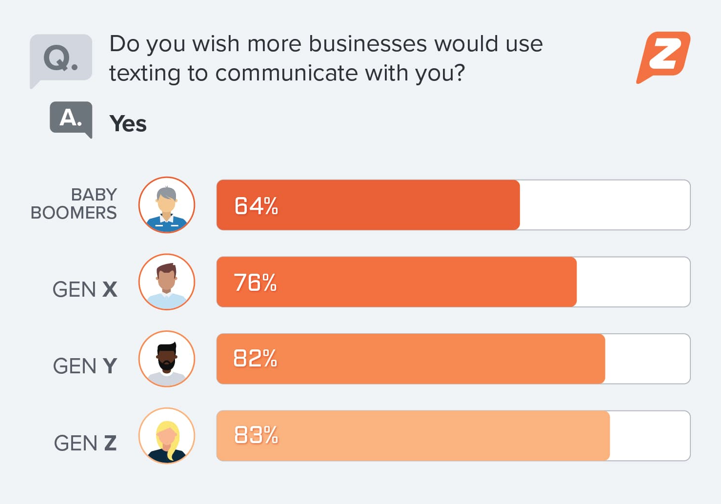
Text abbreviations and acronyms are necessary, both online in social media and in your text
conversations with customers, colleagues, and other businesses.
Even if you don’t use them, your customers will, so you need to understand the common text abbreviations in order to communicate effectively as a business.
In addition, some text language abbreviations can be used in a professional context to improve your text communication.
Business text abbreviations
When you are texting co-workers or other businesses, you can rely on most people to recognize the following common abbreviations. Some of these abbreviations are also fairly well-known among average consumers as well. Here is a text abbreviations list with the most popular business acronyms:
BAU – Business as usual
Including BAU is a quick way to let people know your company will be operating normally, which can be useful if current events have created uncertainty about whether businesses will be open in your area.
1. DND-Do not disturb
DND lets co-workers know you are busy with something important at the moment. It is useful to schedule DND texts for your team before an important meeting or create an automated DND response while your phone is on silent.
2. EOD – End of day
EOD establishes a rough deadline, which can be used if you don’t know exactly when a task or order will be ready but want to give assurance that it will be handled today.
3. ETA – Estimated time of arrival
Texting ETA lets the recipient know when to expect an order or update. If a team member is waiting for you to upload important information or files, or a customer is waiting for an urgent delivery, an ETA text can help them plan around its arrival.
4. ICYMI – In case you missed it
Internally, ICYMI is often used to update absent employees about meetings and other important information they were not present for. When texting customers, this could remind users to read your newsletter or take advantage of a sale that is about to end.
5. OOH – Out of hours
Use OOH to let people know at which times they will not get a response from you. Creating automated OOO and OOH responses is useful for setting expectations when someone texts you outside of working hours.
6. OOO – Out of office
OOO lets customers or employees know that you are not available, and usually also provides the time or date you will be back again.
7. T&C – Terms & conditions
When you need to link to your terms and conditions in a text message, T&C can help shorten the message and sounds a little less stiff and serious.
8. TBA/TBD – To be announced/To Be decided
TBA and TBD can prevent a lot of unnecessary queries about a new product or promotion that you have not yet finalized.
9. WIP – Work in progress
If you are sending a work file to your team for feedback or just to show them the project taking shape, WIP reminds them it is unfinished.
Common text abbreviations
The following text abbreviations are not specific to business use, but they can be useful to communicate more casually with both customers and your team members. These will almost certainly appear in your incoming texts at some point, and you can safely use them in text conversations without setting the wrong tone.
- AFK – Away from keyboard
It is a common way for computer users to say they are going offline temporarily.
- AKA – Also known as
AKA provides other names a business, product or technology might be known by.
- ASAP – As soon as possible
An urgent response to the text is needed.
- FYI – For your information
FYI can introduce important information such as meeting notes for employees, or order details for customers.
- LMGTFY – Let me Google that for you
LMGTFY is a polite way of telling someone they should look something up for themselves.
- N/A – Not applicable or Not available
N/A is used when a question or situation does not apply to you.
- NRN – No reply necessary
NRN is a quick way to assure customers that you no longer require their input, for example when you need to confirm their request was solved and the issue will be closed right after
- TIA – Thanks in advance
TIA can make requests made over text more friendly and polite.
Casual text abbreviations
Most of the following abbreviations are too informal or open to misinterpretation for you to use, but there is still value in knowing them. They might still appear in texts sent to your business, and also in social media posts or reviews online.
It can be difficult to know what people are trying to say without knowing these common text abbreviations! Questions like “What does bbl mean in texting?”, “What does ty mean in a text message” or “What is IDC in texting?” will find their answer below:
- /s – Sarcasm
- AFAIK – As far as I know
- BBL – Be back later
- BC – Because
- BRB – Be right back
- BTW – By the way
- CYA – See ya!
- DM – Direct message
- FWIW – For what it’s worth
- GN – Goodnight!
- GTG – Got to go
- IDC – I don’t care
- IDK – I don’t know
- IIRC – If I remember correctly
- ILY – I love you
- IMO/IMHO – In my opinion/In my humble opinion
- IRL – In real life
- JK – Just kidding
- LMK – Let me know
- NBD – No big deal
- NGL – Not gonna lie
- NP – No problem
- NVM – Never mind
- OIC – Oh, I see!
- OMW – On my way!
- OT – Off-topic
- RN – Right now
- SMH – Shaking my head
- SO – Significant other
- TBC – To be continued
- TBH – To be honest
- THX – Thanks!
- TL;DR – Too long; Didn’t read
- TMI – Too much information
- TTYL – Talk to you later
- TY – Thank you
- TYSM – Thank you so much
- W/O – Without
Why should you know text abbreviations?
Knowing the common text abbreviations is a necessary part of being able to talk easily over text. 64% of baby boomers and 83% of generation Z want businesses to text more, so you can’t afford to be out of touch with everyday acronyms.

Improve customer experience
In addition to simply being able to read your incoming texts without confusion, using text abbreviations can help you set a more relaxed tone to connect with customers.
It also lets customers know they can use texting abbreviations themselves. This can save them time and make texting within your business more convenient. While your business is able to use texting apps and templates to quickly send messages, it is important to remember that your clients aren’t.
Improve readability
Furthermore, good use of text abbreviations makes your messages shorter and easier to read. The average smartphone screen can only display a handful of words per line, so text abbreviations can help reduce the amount of space a sentence occupies. Shortening messages by using the right SMS language can also reduce your cost per text.
Mistakes to avoid
While using text abbreviations can help you save time and communicate more effectively with customers and your team, take care to avoid sending texts that are unprofessional or hard to understand. Knowing chat abbreviations and their meanings is important, but knowing the right context in which they can be used is crucial.
These are the 6 most common mistakes you should avoid:
- Texting shorthand
Text abbreviations are not the same as using shortened spellings or replacing words with numbers. Texting shorthand such as u instead of you or gr8 instead of great makes your message harder to read, and can seem childish or lazy to many recipients. - Overuse of abbreviations
Much like texting shorthand, using too many abbreviations and acronyms in your message will have an impact on its readability. Additionally, it can be off-putting to the reader in the same way as a message full of jargon or buzzwords.Limit yourself to just a few abbreviations per text, and don’t try to string a sentence together entirely.
- Obscure abbreviations
Text abbreviations only aid communication if everyone knows what they mean.
When texting customers, avoid using business acronyms that your average customer can’t be expected to know, not to mention slang acronyms. - Inappropriate abbreviations
Text abbreviations like wtf are often used so casually that their actual meaning gets forgotten. If you would not text the full phrase in a business context, don’t use the acronym either.
- Using abbreviations at the wrong time
Text abbreviations usually imply a more casual and informal tone. While this is great for connecting with customers, it could cause annoyance if your recipient expects you to be more formal. When you need to send bad news, such as a cancellation or delay, using text abbreviations may not be the best way to assure your customer you are taking the issue seriously.
- Using an abbreviation you don’t understand
This is fairly obvious, but trying to use an abbreviation you don’t know the meaning of could backfire. Similarly, if someone texts you an abbreviation you don’t recognize, you can always Google it.
Conclusion
These text message abbreviations will help you understand clients and communicate better with your team.
Text abbreviations and text slang words are a part of everyday conversation, and as a result, it is important to understand how to use them appropriately in order to avoid giving the wrong impression. Following these tips will enable you to better connect with customers and your team via text messaging.
Frequently Asked Questions
Text abbreviations are shortened forms of words or phrases commonly used in digital communication to save time and reduce character count. They facilitate communication without sacrificing clarity when used appropriately.
Commonly used abbreviations include “FYI” (For Your Information), “ETA” (Estimated Time of Arrival), “ASAP” (As Soon As Possible), and “BRB” (Be Right Back). Familiarity with widely accepted terms ensures smoother communication, especially when using platforms like Textmagic to send professional, high-volume SMS campaigns.
When communicating in a professional context, the best approach is to use only well-established and universally recognized abbreviations. If in doubt, focus on clarity. With Textmagic, message previews and testing capabilities allow businesses to evaluate the effectiveness and readability of their content before it reaches the recipient.
Text abbreviations can be appropriate when used with discretion and clarity in business messaging. However, to maintain professionalism in customer interactions, they should be limited to widely recognized terms.
Yes. When relevant and clearly understood by the audience, abbreviations can help improve engagement by making messages more concise and accessible. With Textmagic, businesses can test message formats and analyze performance metrics to determine which variations generate stronger response rates.
Acronyms (e.g., NASA) are pronounced as words, initialisms (e.g., SMS) are read letter by letter, and abbreviations (e.g., “appt” for “appointment”) are shortened forms of whole words or phrases. Understanding these distinctions is essential for clear written communication.
Related articles
Transactional SMS explained: Why should your business use it?
In the crowded world of email communications, where ...
A guide to WhatsApp customer service with Textmagic
Using WhatsApp for customer service with Textmagic a...
Smishing uncovered: How to protect yourself from SMS phishing and fraud
At one point or another, you might have gotten one o...
6 Strategic communication plan templates for your team
Have you ever wondered how to ensure everyone in you...
How to elevate customer service through automated email responses
Check out the best practices for automating support ...




